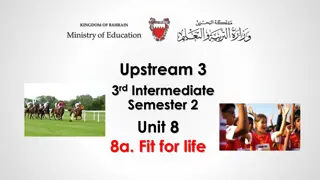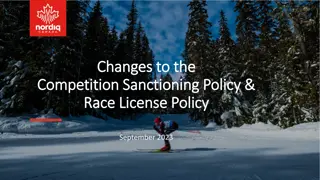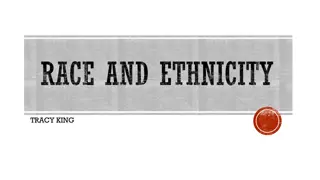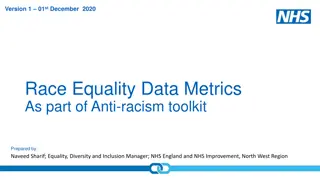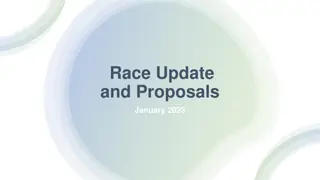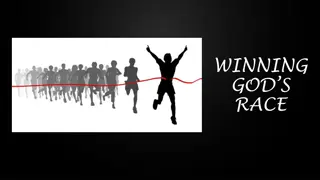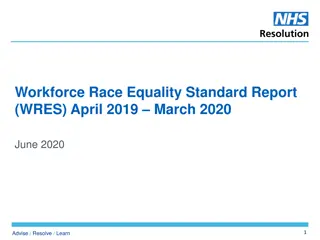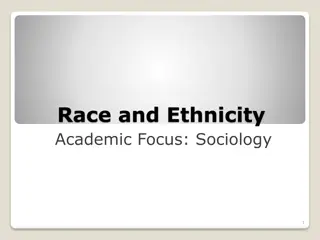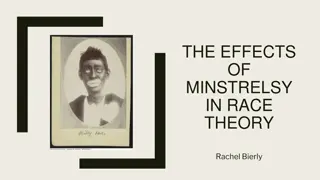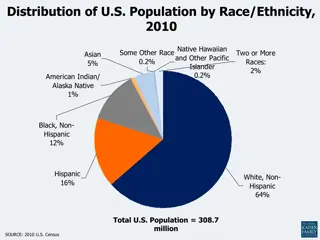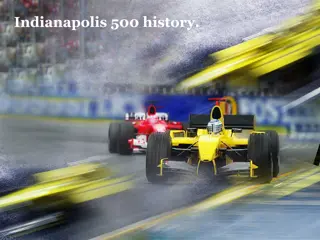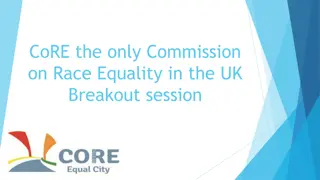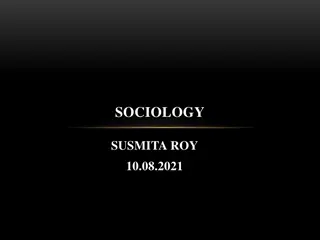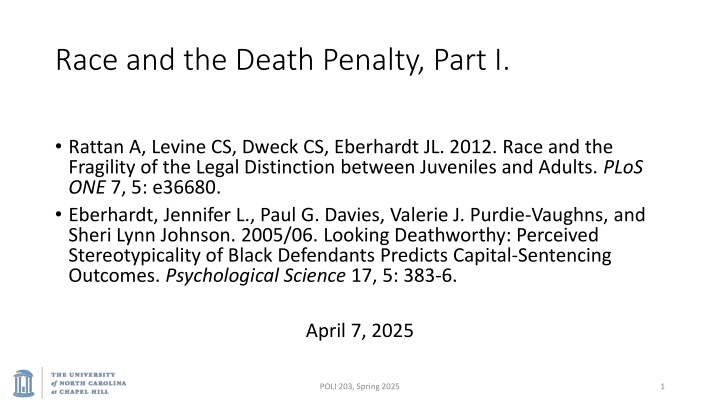
Race and the Death Penalty Research Findings
Explore the impact of race on death penalty decisions through psychological studies, examining attitudes towards juvenile offenders and the perceived deathworthiness of black defendants. Delve into discussions on adultification and the super-predator scare, shedding light on societal perceptions of criminal responsibility. Learn from research findings on racial biases in the legal system and the complexities surrounding juvenile sentencing.
Download Presentation

Please find below an Image/Link to download the presentation.
The content on the website is provided AS IS for your information and personal use only. It may not be sold, licensed, or shared on other websites without obtaining consent from the author. If you encounter any issues during the download, it is possible that the publisher has removed the file from their server.
You are allowed to download the files provided on this website for personal or commercial use, subject to the condition that they are used lawfully. All files are the property of their respective owners.
The content on the website is provided AS IS for your information and personal use only. It may not be sold, licensed, or shared on other websites without obtaining consent from the author.
E N D
Presentation Transcript
Race and the Death Penalty, Part I. Rattan A, Levine CS, Dweck CS, Eberhardt JL. 2012. Race and the Fragility of the Legal Distinction between Juveniles and Adults. PLoS ONE 7, 5: e36680. Eberhardt, Jennifer L., Paul G. Davies, Valerie J. Purdie-Vaughns, and Sheri Lynn Johnson. 2005/06. Looking Deathworthy: Perceived Stereotypicality of Black Defendants Predicts Capital-Sentencing Outcomes. Psychological Science 17, 5: 383-6. April 7, 2025 POLI 203, Spring 2025 1
Rattan, Levine, Dweck and Eberhardt Who is a juvenile, who is an adult? These are psychologists, so they did an experiment Main questions: To what extent do you support life sentences with no possibility of parole for juveniles when they have been convicted of serious violent crimes (in which no one was killed)? (not at all 1 extremely 6 ). How much do you believe that juveniles who commit crimes such as these should be considered less blameworthy than an adult who committed the same crime? (juveniles are less blameworthy than adults 1 juveniles and adults are equally blameworthy 6 ). POLI 203, Spring 2025 2
The manipulation N = 658, national sample of White Americans They read a description of a US SC case about LWOP for juveniles. Embedded in the materials, participants read about an example recipient of this sentencing option: a 14-year-old male with 17 prior juvenile convictions on his record who brutally raped an elderly woman. (This was an actual case.) We manipulated just one word across the two study conditions. In the description of the example recipient of the sentencing option, the juvenile was described as either Black or White (i.e., a [black/ white] male with 17 prior juvenile convictions ). POLI 203, Spring 2025 3
The results POLI 203, Spring 2025 4
Adultification This is definitely a thing. Great object for your own research. When is someone considered just a child who made a mistake, and when are they a delinquent who needs to be tried in adult court? The super-predator scare around 1994 John DiIulio: These new kids are godless,, fatherless, jobless, hopeless, fearless, and remorseless and we need to put them away A 10-minute video from the New York Times about the rise and fall of the "super-predator" idea. POLI 203, Spring 2025 5
Eberhardt study, looking deathworthy First paragraph, all the Baldus studies These studies take hundreds or thousands of homicides that could theoretically have led to a capital prosecution (decision by the DA) or a death sentence (decision by a jury), and see which ones get it. Legally relevant factors: torture, number of victims, etc. Legally irrelevant factors: what county, what year, what gender, what race of the victim(s) or the defendant(s). POLI 203, Spring 2025 6
This study: 600 cases from Philadelphia An actual Baldus study: they got the records and looked up the photos / mug shots 1979-1999, 600 + penalty phase cases. That means people had been found guilty, and now the question would be the penalty. All were eligible for death. 44 cases had black male offenders and white victims. They got these photos and had students rate the photos as stereotypical or not, on a scale. Coders were students, and did not know anything about the photos, even that they were from a death penalty case. POLI 203, Spring 2025 7
32 raters rated each photo on a scale of 1-11 Then they took the average rating, then just combined them into low / high based on the median ranking. So, we have two groups of photos: yes / no or high / low of stereotypicality Note: these were real cases; actual juries were involved and people really got sentenced (or not) Students reviewed photos after the fact, decades later, and coded them as stereotypically African or not POLI 203, Spring 2025 8
Question 1: can you do this? Do you believe these codes? POLI 203, Spring 2025 9
Results from the first study 44 actual cases white victims, black offenders, and a penalty phase hearing Low stereotypicality: 24.4% got death. High stereotypicality: 57.5% got death. POLI 203, Spring 2025 10
Study 2, Black victim, black offender 308 such cases But only 27 percent got death compared with 41 percent with the white victim cases. That s the object of Baldus. (and a big deal) Their interest: does the photo influence the results Select 118 of the 308 cases with over-sampling of the death sentence cases, so they have 46 percent death sentences, 54 percent not. Same study as before: rate the 118 photos for stereotypicality (19 different raters) POLI 203, Spring 2025 11
Results from study 2: Low stereotypicality: 45% High stereotypicality: 47% POLI 203, Spring 2025 12
OK, what the heck: Why would this happen? White victim: 57 v. 24 percent got death Black victim: no difference What s your theory of how that could be? POLI 203, Spring 2025 13
Their idea: Inter-racial crime: Race is more salient as a possible motivation / consideration for the jury But note the finding is that the low stereotypicality group did not get death, so the group conflict theme is apparently more strongly induced by the other ones. Intra-racial crime: Jury may assume the motivation is personal, not group-based Their findings add detail to why we see these large race effects Note that this does not relate at all to the behavior of the DA. Juries are hard to control / train / dissuade from using biases POLI 203, Spring 2025 14
Other ideas about why this happens? Jury composition maybe different where white and black victims? Other ideas? POLI 203, Spring 2025 15
Object of attention > cognitive response When you think of a particular object, be it a political leader, a policy issue such as gun control, abortion, climate change, or whatever it may be, you think of various attributes. Photos and visual cues can affect this very powerfully, not just words. Some common visual cues in politics: Nice suits and ties; flags; good (preppy) grooming; professional attire Flags, flags, flags, patriotic images, families, children, farmers, haystacks, etc. Or: chaos, strife, anger, etc. Useful to think of the power of these visual cues. POLI 203, Spring 2025 16
Martin Shkreli, no good PR here; (pharma boy) POLI 203, Spring 2025 17
Ed Chapmans perp photo, then after he was released. POLI 203, Spring 2025 18
Khalid Sheik Muhammad, (9-11 Mastermind) The Perp Photo, very commonly used before his trial An alternative view POLI 203, Spring 2025 19
Politicians never leave these images to chance POLI 203, Spring 2025 20
And they don t stop even after they retire POLI 203, Spring 2025 21
The power of visual images Most studies of framing focus on text, words But think of photos; they convey a lot of information Certainly a good research project would be to analyze widely shared photos, particularly of cases involving the police, criminal investigations. The DA typically releases certain photos or stages a perp walk where photos can be taken Feel free to use / analyze images in your papers, if appropriate. What images show up in the paper? How are victims of police shootings portrayed by their supporters and by the authorities? Which images do mainstream news outlets pick up? POLI 203, Spring 2025 22
Race and visual images It s not only the visual character of the images of race. It s the accumulation of 400 years of associations in our minds It s the association of white feminity as something to hold in a special place of protection It s the idea that a successful or middle-class person s killing is more important than another killing. It s the idea that black (or Latin) children are actually adults. It s the idea that whites face a threat from blacks, when really whites have more often been on the side of violence It s deeply connected to our views on punishment and the death penalty. POLI 203, Spring 2025 23

![❤[PDF]⚡ Escaping from Eden: Does Genesis Teach that the Human Race was Created](/thumb/21697/pdf-escaping-from-eden-does-genesis-teach-that-the-human-race-was-created.jpg)
